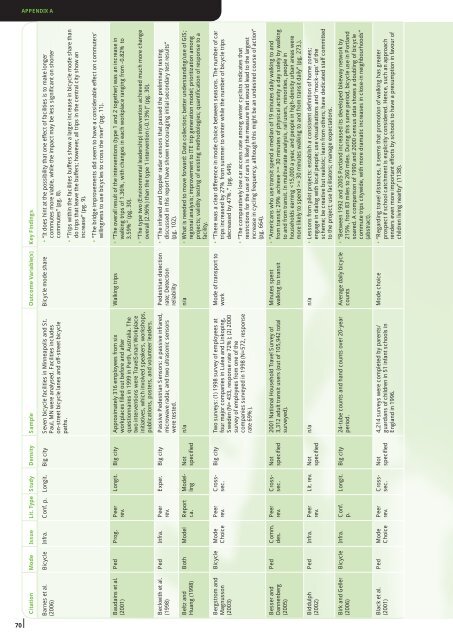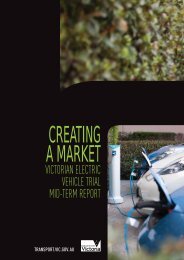Walking and Cycling International Literature Review - Department of ...
Walking and Cycling International Literature Review - Department of ...
Walking and Cycling International Literature Review - Department of ...
Create successful ePaper yourself
Turn your PDF publications into a flip-book with our unique Google optimized e-Paper software.
APPENDIX A<br />
Citation Mode Issue Lit. Type Study Density Sample Outcome Variable(s) Key Findings<br />
Barnes et al.<br />
(2006)<br />
Bicycle Infra. Conf. p. Longit. Big city Seven bicycle facilities in Minneapolis <strong>and</strong> St.<br />
Paul, MN were analysed. Facilities includes<br />
on-street bicycle lanes <strong>and</strong> <strong>of</strong>f-street bicycle<br />
paths.<br />
Bicycle mode share • “It does hint at the possibility that one effect <strong>of</strong> facilities is to make longer<br />
commutes more viable, while the impact may be less significant on shorter<br />
commutes” (pg. 8).<br />
• “Trips within the facilities buffers show a larger increase in bicycle mode share than<br />
do trips that leave the buffers; however, all trips in the central city show an<br />
increase” (pg. 9).<br />
• “The bridge improvements did seem to have a considerable effect on commuters’<br />
willingness to use bicycles to cross the river” (pg. 11).<br />
Baudains et al.<br />
(2001)<br />
Ped Prog. Peer<br />
rev.<br />
Longit. Big city Approximately 316 employees from six<br />
workplaces filled out before <strong>and</strong> after<br />
questionnaires in 1999 in Perth, Australia. The<br />
two interventions were TravelSmart Workplace<br />
initiatives, which involved speakers, workshops,<br />
publications, posters, <strong>and</strong> volunteer leaders.<br />
<strong>Walking</strong> trips • “The overall result <strong>of</strong> the interventions (type 1 <strong>and</strong> 2 together) was an increase in<br />
walking trips <strong>of</strong> 1.36%, with changes in each workplace ranging from -0.82% to<br />
3.59%” (pg. 30).<br />
• “The type two (Environmental leadership) intervention achieved much more change<br />
overall (2.96%) than the type 1 intervention (-0.13%)” (pg. 30).<br />
Beckwith et al.<br />
(1998)<br />
Ped Infra. Peer<br />
rev.<br />
Exper. Big city Passive Pedestrian Sensors: a passive infrared,<br />
microwave radar, <strong>and</strong> two ultrasonic sensors<br />
were tested.<br />
Pedestrian detection<br />
rate; Detection<br />
reliability<br />
• “The infrared <strong>and</strong> Doppler radar censors that passed the preliminary testing<br />
discussed in this report have shown encouraging initial secondary test results”<br />
(pg. 102).<br />
Beltz <strong>and</strong><br />
Huang (1998)<br />
Both Model Report<br />
r.a.<br />
Not<br />
specified<br />
n/a n/a • What is needed to move forward: Data collection; better underst<strong>and</strong>ing/use <strong>of</strong> GIS;<br />
regional analysis; improvement to ITE trip generation model; prioritization among<br />
projects; validity testing <strong>of</strong> existing methodologies; quantification <strong>of</strong> response to a<br />
facility.<br />
Bergstrom <strong>and</strong><br />
Magnusson<br />
(2003)<br />
Bicycle Mode<br />
Choice<br />
Peer<br />
rev.<br />
Big city Two surveys: (1) 1998 survey <strong>of</strong> employees at<br />
four major companies in Lulea <strong>and</strong> Linkoping,<br />
Sweden (N= 433, response rate 72%); (2) 2000<br />
survey <strong>of</strong> employees from one <strong>of</strong> the<br />
companies surveyed in 1998 (N=572, response<br />
rate 69%).<br />
Mode <strong>of</strong> transport to<br />
work<br />
• “There was a clear difference in mode choice between seasons. The number <strong>of</strong> car<br />
trips increased by 27% from summer to winter while the number <strong>of</strong> bicycle trips<br />
decreased by 47%.” (pg. 649).<br />
• “The comparatively low car access rate among winter cyclists indicates that<br />
restrictions for the use <strong>of</strong> cars is likely the measure that would lead to the largest<br />
increase in cycling frequency, although this might be an undesired course <strong>of</strong> action”<br />
(pg. 664).<br />
Besser <strong>and</strong><br />
Dannenberg<br />
(2005)<br />
Ped Comm.<br />
des.<br />
Peer<br />
rev.<br />
Not<br />
specified<br />
2001 National Household Travel Survey <strong>of</strong><br />
3,312 adult transit users (out <strong>of</strong> 105,942 total<br />
surveyed).<br />
Minutes spent<br />
walking to transit<br />
• “Americans who use transit spend a median <strong>of</strong> 19 minutes daily walking to <strong>and</strong><br />
from transit; 29% achieve >= 30 minutes <strong>of</strong> physical activity a day solely by walking<br />
to <strong>and</strong> from transit. In multivariate analysis, rail users, minorities, people in<br />
households earning = 30 minutes walking to <strong>and</strong> from transit daily” (pg. 273.).<br />
Biddulph<br />
(2002)<br />
Ped Infra. Peer<br />
rev.<br />
Lit. rev. Not<br />
specified<br />
n/a n/a • Lessons from pilot projects: establish a consistent definition <strong>of</strong> home zones;<br />
engage in dialog with local people; use visualisations <strong>and</strong> ‘mock-ups’ <strong>of</strong> the<br />
scheme; be creative but realistic; learn from others; have dedicated staff committed<br />
to the project; use facilitators; manage expectations.<br />
Birk <strong>and</strong> Geller<br />
(2006)<br />
Bicycle Infra. Conf.<br />
p.<br />
Longit. Big city 24-tube counts <strong>and</strong> h<strong>and</strong> counts over 20-year<br />
period.<br />
Average daily bicycle<br />
counts<br />
• “Between 1992 <strong>and</strong> 2005 Portl<strong>and</strong> increased its developed bikeway network by<br />
215%, from 83 miles to 260 miles. During this same period, bicycle use in Portl<strong>and</strong><br />
soared. A comparison <strong>of</strong> 1990 <strong>and</strong> 2000 census data shows a doubling <strong>of</strong> bicycle<br />
commute trips citywide, with more dramatic increases in close-in neighbourhoods”<br />
(abstract).<br />
Black et al.<br />
(2001)<br />
Ped Mode<br />
Choice<br />
Peer<br />
rev.<br />
Modelling<br />
Crosssec.<br />
Crosssec.<br />
Crosssec.<br />
Not<br />
specified<br />
4,214 surveys were completed by parents/<br />
guardians <strong>of</strong> children in 51 infant schools in<br />
Engl<strong>and</strong> in 1996.<br />
Mode choice • “Regarding travel distances, it seems that promotion <strong>of</strong> walking has greater<br />
prospect if school catchment is explicitly considered. Hence, such an approach<br />
renders even more important efforts by schools to have a presumption in favour <strong>of</strong><br />
children living nearby” (1138).<br />
70

















